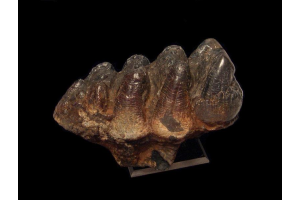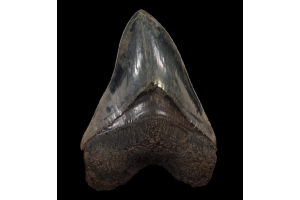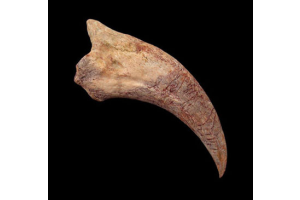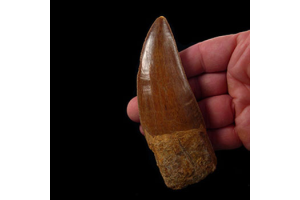Page 6 - Home Page Latest Post
- - August 05, 2025
You probably didn’t set out today looking to uncover a prehistoric dental anomaly. But now that you’re here, it’s worth leaning in.
Somewhere beneath the sediment-heavy layers of Morocco’s phosphate-rich terrain, a story has been waiting. It isn’t told in words. It’s etched in enamel, twisted in form, compressed in angles that feel both deliberate and accidental. A tooth, once nestled in the jaw of a megalodon—the ocean’s most formidable predator—emerged with an unexpected shape. Warped at the crown and compressed at the base. Split cleanly down the center like a rift in time.
At first glance, it might look broken. Imperfect. But these deviations aren’t mistakes. They’re pathologies—developmental mutations caused by trauma, spatial pressure, or biological quirks deep within the shark’s physiology. They’re rare, raw, and completely natural. And when you see a pathological megalodon tooth for sale, you’re not just looking at a fossil. You’re looking at a prehistoric record of biological
- - August 05, 2025
It begins with a single fossil—cold in the hand, serrated at the edge, shaped by time into a symbol of prehistoric dominance. One glance is enough. The texture, the weight, the silent story embedded in its enamel—it captures attention, then obsession. That’s the moment it happens: the realization that this belongs not in a museum, but in your personal collection.
You wouldn’t be the first to feel it. Interest in megalodon shark teeth for sale hasn’t simply risen—it’s surged. Not because a trend told people to care. Because the fossil itself did. Because once someone sees that heart-shaped shard of marine terror, they don’t forget it. It doesn’t politely suggest. It declares, with quiet certainty: I once tore through whales.
That is all it takes. From that moment forward, these teeth vanish from our inventory at a pace that rivals the predator that created them.
The apex predator of apex predators
The Megalodon was not merely large—it was a true apex predator, unparalleled in prehistoric
- - August 05, 2025
What if the key to understanding one of Earth’s most awe-inspiring sea predators was resting in the palm of your hand? That’s the intriguing possibility paleontologists face when they study a big Megalodon tooth. These fossilized remnants are more than just relics—they’re time capsules offering a glimpse into the world of the Megalodon, an enormous prehistoric shark that ruled the oceans millions of years ago. But how can just one tooth reveal so much?
Let’s dive into how researchers use these ancient teeth to piece together the story of the Megalodon’s life, diet, and ultimate extinction—and how you can tell if you're holding the real deal or just a clever imitation.
Why Are Megalodon Teeth So Valuable to Science?
While most of a Megalodon’s body was made of cartilage (which doesn’t fossilize well), its teeth were built to last. These massive, serrated structures are among the only surviving clues to this prehistoric predator’s existence. And because a single Megalodon could shed
- - August 05, 2025
Few fossils stir the imagination quite like the massive, serrated teeth of the Megalodon. These prehistoric remnants continue to captivate us, not just for their size, but for the secrets they reveal about a long-extinct ocean predator. From scientific discoveries to cultural legends, Megalodon teeth hold a special place in our collective curiosity. Their enduring allure speaks to our fascination with the unknown depths of Earth’s history.
A Prehistoric Predator That Still Captivates the Imagination
There’s something undeniably gripping about holding a fossil in your hand—especially when it’s a serrated, heart-shaped tooth from a predator that once ruled the oceans. The Megalodon, whose name literally means "big tooth," swam Earth's oceans over 3 million years ago, and yet its fossilized remains—particularly its teeth—continue to fascinate scientists, fossil collectors, and curious minds alike.
These prehistoric remnants have inspired countless documentaries, books, and collections. For
- - August 05, 2025
Before museums or coin collections ever existed, ancient humans may have prized something even more captivating—a massive tooth from the king of sharks. These weren’t just fossils; they were symbols of power, mystery, and survival. Today, that same fascination lives on through collectors who cherish each serrated relic. A genuine megalodon tooth fossil isn't just a find—it's a link to a time when giants ruled the sea.
Prehistoric Souvenirs from the Deep
Long before coin hoards, baseball cards, or comic books fascinated collectors, our ancestors might have held on to something just as mesmerizing—giant fossilized teeth from the king of ancient seas: the Megalodon. These massive shark teeth, buried in sediment for millions of years, may have been the first "collectibles" for early humans, not for their monetary value, but as tools, symbols, or talismans.
The idea that a megalodon tooth fossil could hold value across multiple eras bridges an extraordinary connection between ancient civilizations
- - August 05, 2025
When it comes to prehistoric predators, few creatures captivate the imagination quite like the Megalodon. This ancient shark, whose very name means "big tooth," ruled the oceans millions of years ago with a jaw-dropping presence—literally. But was the Megalodon truly the owner of the largest teeth on Earth in history? To answer that, we’ll take a deep dive into its famous dentition, compare it with other fearsome giants like the Tyrannosaurus rex and saber-toothed cats, and look at why size isn’t the only thing that matters when evaluating prehistoric power.
A Closer Look at Megalodon’s Formidable Fangs
The Megalodon’s teeth are among the most sought-after fossils in the world. Not just because of their connection to a legendary predator, but because their sheer size is awe-inspiring. These fossilized relics can range from small, two-inch specimens to gigantic seven-inch monsters. Megalodon tooth size plays a key role in understanding both the scale of this animal and its dominance as an
- - August 05, 2025
Fossil collectors often seek perfection—but the real prize might be in the imperfections. Pathologic shark teeth, with their twisted shapes and rare deformities, tell deeper stories from ancient oceans. Each one is a natural anomaly, turning fossil hunting into true discovery. That’s why a pathological Megalodon tooth for sale is more than rare—it’s remarkable.
What Makes a Fossil Truly Fascinating?
If you're a fossil collector, you've probably spent hours sifting through ammonites, trilobites, and the occasional Megalodon tooth. But every so often, something grabs your attention and just won’t let go—something rare, mysterious, and visually striking. That’s exactly what pathologic teeth represent. These aren't your average prehistoric finds. They’re nature’s oddities, anomalies born from trauma, genetics, or environmental stress during tooth formation. They are the fossils that make you stop and say, “Now this is special.”
When I first saw a pathological Megalodon tooth for sale, it wasn’t
- - August 05, 2025
There’s something undeniably captivating about holding a piece of prehistory in your hands—especially when that piece once belonged to a creature the size of a city bus, armed with the most powerful bite in natural history. For collectors, scientists, and even interior design enthusiasts, fossilized shark teeth—particularly those from the Megalodon—have become treasured artifacts, often commanding prices in the thousands. But what’s driving this fascination?
As collectors ourselves, we understand that it’s more than just the price tag or bragging rights. From scientific rarity to visual intrigue, a megalodon tooth is more than a fossil—it’s a conversation starter, a museum-worthy display piece, and a literal slice of ancient life.
The Legend of the Megalodon: A Giant Among Sharks
Before we dive into the collecting world, it’s worth appreciating the beast behind the bite. The Megalodon shark was an oceanic juggernaut that lived between 23 and 3.6 million years ago during the Miocene
- - August 05, 2025
If you’ve ever walked along the beaches of North Carolina and spotted a large, triangle-shaped tooth buried in the sand, you might have just discovered something truly ancient—a megalodon tooth. These massive fossilized teeth are more than just beach treasures. They are clues to the past. But why do so many of them wash up on North Carolina shores? Let’s dive in.
A Prehistoric Predator and Its Teeth
Millions of years ago, the oceans were ruled by a giant shark called Otodus megalodon. This predator could grow over 50 feet long. It had a mouth filled with huge, serrated teeth. One tooth could be over 7 inches long!
The megalodon didn’t just have big teeth—it had thousands of them. Like modern sharks, it constantly sheds old teeth while growing new ones. Over a lifetime, a megalodon may have lost tens of thousands of teeth. These teeth dropped to the ocean floor, where many got buried by sand and sediment.
Why the Coast of North Carolina?
Now let’s talk about why so many megalodon teeth
- - August 05, 2025
The Megalodon, often called the king of ancient seas, is one of the most fascinating sharks to ever live. This giant predator ruled the oceans for millions of years before going extinct. But what if it didn’t? What if the Megalodon still existed today? This question sparks the imagination of many shark lovers, collectors, and scientists. It’s thrilling to think about how our oceans and our world might look if this ancient giant still swam beneath the waves.
In this blog, we’ll take a deep dive into the possibilities, from the impact on the food chain to how we might interact with such a powerful creature. If you’re someone who loves collecting fossils, especially an authentic megalodon tooth, you’ll find this journey into “what if” both exciting and thought-provoking.
Understanding the Megalodon
Before we imagine today’s world with a living Megalodon, let’s take a quick look at what we know about it. The Megalodon lived around 23 to 3.6 million years ago. It was the largest shark ever







